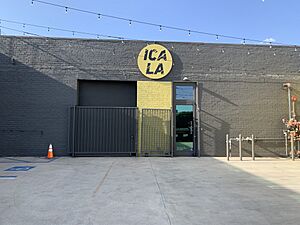Institute of Contemporary Art, Los Angeles facts for kids
 |
|
| Established | 1984 |
|---|---|
| Location | 1717 East 7th Street Los Angeles, CA 90021 |
| Type | Art |
The Institute of Contemporary Art, Los Angeles (ICA LA) is an exciting art museum located in Los Angeles, California, United States. It's a special kind of art museum because it doesn't collect art. Instead, it focuses on showing new and interesting works by artists from Los Angeles and all around the world.
For many years, the museum was known as the Santa Monica Museum of Art. It was located in Santa Monica, California. In 2016, the museum changed its name to ICA LA and moved to the Downtown Arts District in Los Angeles. It opened its doors to the public in September 2017.
History of the Museum
The museum first started in 1984 as the Santa Monica Museum of Art (SMMoA). It was founded by Abby Sher. The museum was originally part of a building complex designed by the famous architect Frank Gehry.
In 1988, Thomas Rhoads became the museum's director. He organized the first art show there. Later, in 1998, SMMoA moved to a new location called Bergamot Station Arts Center.
After raising $5 million, the museum moved to Downtown Los Angeles in 2017. A company called wHY Architecture helped to change an old factory building into the museum's new home.
The museum's main goal is to show art that helps people discover new things and challenges how they see the world. ICA LA wants to support art that breaks down old ideas about race, class, and gender. They do this through art shows, learning programs, and working with the community. In 2024, the museum announced plans to buy and update its building.
Amazing Art Shows
From the very beginning, the museum became known for showing groundbreaking art. Many artists who later became very famous had their early shows here.
When the museum was still SMMoA, it featured artists like Andrea Bowers and Meg Cranston. It also held the first solo shows for artists such as Daniel J. Martinez and Jennifer Steinkamp. When the museum moved to Bergamot Station, it continued to show new artists. One of the first shows there featured Liza Lou and her amazing kitchen and backyard art made entirely of beads.
Elsa Longhauser became the executive director in 2000. She brought shows by artists like Yoshimoto Nara and Urs Fischer. Other important shows included The Book Show: Raymond Pettibon and Cavepainting: Laura Owens, Chris Ofili, Peter Doig. The museum also hosted shows put together by guest curators, like Semina Culture: Wallace Berman and His Circle.
Fun Programs and Learning
The museum offers many free programs for the public. These include talks and discussions about art. They also have award-winning education programs for kids in kindergarten through 12th grade.
One popular program was Park Studio. This was a free, week-long art workshop series. It happened during school spring breaks. Another great program was Wall Works. This program connected K-12 students directly with famous modern artists. Students created their own art projects in the classroom. Their work was then shown to the public at Bergamot Station Arts Center. Artists like Olga Koumoundouros and Peter Shire have worked with students in these programs.
The museum also had a public program called A Collection of Ideas…. This series brought in creative thinkers from different fields to give talks.
SMMoA also had "Cause for Creativity" (C4C) workshops. These workshops mixed art with social action and community work. The motto was "Make art and make a difference." These programs were for people of all ages. Groups like The Echo Park Film Center and Cirque du Soleil’s OVO have taught workshops.
Museum Leadership
Thomas Rhoads was the museum's first executive director. In 2000, Elsa Longhauser took over this role. She led the museum for many years. In July 2019, Anne Ellegood became the museum's new executive director. She used to be a senior curator at the Hammer Museum.
Amanda Sroka is currently the senior curator at ICA LA. Asuka Hisa is the curator for education and programs. Other important curators who have worked at the museum include Lisa Melandri and Jamillah James.

